Photo: Paul Rudderow
Steve picks up from last week’s look at hockey’s perseverance rating and goalkeeping and how it can be applied to soccer with a look at Union goalkeepers through their short history.
The last major expansion team still extant that arrived prior to the Philadelphia Union was the National Hockey League’s Philadelphia Flyers. And, in that most important position of goal, Flyers fans were spoiled: from 1967 to 1979, the team basically relied on two goaltenders–Bernie Parent and Doug Favell. Sometimes together (1967 to 1971), sometimes apart (Favell from 1971-73, Parent from 1973-79), the two men anchored the Flyers’ nets for the first twelve seasons of the team’s existence.
Perhaps the two were meant to be together–in fact, while other NHL expansion teams were drafting aging future Hall of Famers like Glenn Hall and Terry Sawchuck, the Flyers drafted both Parent and Favell out of the same organization (the Boston Bruins). Ultimately, the very-popular Favell was traded to re-acquire Parent–a move that was not applauded by Flyers Nation at the time, but was quickly accepted as Bernie went on a remarkable two-year run, winning consecutive Vezina (for best goaltender) and Conn Smythe (for playoff MVP) trophies while the team won its only two Stanley Cups.
(Hockey being hockey, there have been some notable backups–like Bruce Gamble (who had a heart attack one period and finished playing the game–yes, hockey players are a different breed)–but Parent and Favell were always unquestionably 1 and 1a on the depth chart in the years they played. For example, Parent played 73 out of 78 games in 1973-74, while backup Bobby Taylor knitted toques or something).
The point is, the Flyers struck gold from the start, and got a good dozen years out of their first two expansion draft picks.
What’s with the hockey? Get to the point…
Anyway, the Philadelphia Union have not been so lucky.
In four years, the Union have burned through the two goalkeepers it acquired on expansion draft day (Chris Seitz and Brad Knighton) and a big international signing (Faryd Mondragron), and is currently using a number one pick (Zac MacMath). Four years, four goalkeepers. And, in that short time, Seitz and Knighton are remembered as bumblers, Mondragon considered a saint, and MacMath a work-in-progress.
But were they?
Last time out, we looked at a “perseverance rating” used in hockey (essentially a weighted save percentage based on total shots faced), and examined some performances from Major League Soccer and North American Soccer League keepers from seasons past. Now we are going to apply the same formula (with all of its faults, as acknowledged last time out) so see whether our memories of Seitz, Knighton, Mondragon and MacMath square up with the data.
2010
Although the Union drafted Brad Knighton from New England during the expansion draft on November 25, 2009, more excitement was generated by the draft-day acquisition of former U.S. U-23 goalkeeper Chris Seitz from Real Salt Lake for approximately $200,000 in allocation money. Widely considered one of the best young keepers in the country, Seitz was expected to give the new Philadelphia team a solid presence in net, and would be a fundamental building block for the team going forward.
We all remember what happened next.
After getting embarrassed in the U’s inaugural home opener before 35,000 fans at the Linc after D.C. United forward Jaime Moreno stole the ball off an attempted punt (albeit illegally) and scored, Seitz showed himself to have hands of stone, fumbling many balls in the box and conceding a number of easy goals that often turned wins to draws, or draws to losses. He was quickly vilified as one of the biggest busts of that first season, and few tears were shed when he was left exposed by the Union in the 2011 Re-Entry Draft (where he was drafted by Seattle, who promptly shipped him off to FC Dallas).
But was he really that bad?
Let’s look at the stats:
|
Name |
Team |
Min. |
Svs |
GA |
ShO |
GAA |
PR |
+/- |
|
|
1 |
Kevin Hartman |
Dallas |
1755 |
56 |
12 |
9 |
0.62 |
827.40 |
97.94 |
|
2 |
Jon Busch |
San Jose |
1620 |
81 |
19 |
7 |
1.06 |
816.17 |
87.84 |
|
3 |
Bouna Coundoul |
New York |
2430 |
105 |
28 |
11 |
1.04 |
794.95 |
68.73 |
|
4 |
Donovan Ricketts |
Los Angeles |
2610 |
79 |
26 |
11 |
0.90 |
756.40 |
34.04 |
|
5 |
Stefan Frei |
Toronto |
2520 |
108 |
37 |
8 |
1.32 |
750.58 |
28.80 |
|
6 |
Matt Pickens |
Colorado |
2610 |
88 |
32 |
7 |
1.10 |
737.93 |
17.42 |
|
7 |
Andrew Dykstra |
Chicago |
1530 |
55 |
21 |
5 |
1.24 |
728.65 |
9.07 |
|
8 |
William Hesmer |
Columbus |
2695 |
84 |
33 |
11 |
1.10 |
722.29 |
3.34 |
|
9 |
Kasey Keller |
Seattle |
2655 |
82 |
34 |
11 |
1.15 |
711.27 |
-6.58 |
|
10 |
Jimmy Nielsen |
Kansas City |
2610 |
80 |
34 |
10 |
1.17 |
706.12 |
-11.21 |
|
11 |
Troy Perkins |
DC United |
1980 |
72 |
37 |
5 |
1.68 |
666.06 |
-47.27 |
|
12 |
Zach Thornton |
Chivas USA |
2015 |
63 |
33 |
6 |
1.47 |
661.01 |
-51.81 |
|
13 |
Nick Rimando |
Real Salt Lake |
2430 |
63 |
33 |
14 |
1.22 |
660.20 |
-52.54 |
|
14 |
Chris Seitz |
Philadelphia |
2047 |
68 |
41 |
0 |
1.80 |
629.18 |
-80.46 |
|
15 |
Pat Onstad |
Houston |
2070 |
49 |
40 |
4 |
1.74 |
554.86 |
-147.34 |
Yep…it turns out Seitz the Sieve was every bit as bad as we remember him, posting an absolutely atrocious Perseverance Rating that was a full 80 points below the league average, and a mere 118 points off the pace set by FC Dallas goalkeeper Kevin Hartman.
If it is any consolation, Seitz was consistently bad–his goals against average was the worst in MLS, and–unlike every other goalkeeper with enough minutes to qualify–he could not even be good enough for 90 minutes to post a shutout. By comparison, even though Pat Onstad (in his last season) managed to put up a stinker for the ages, he managed to be good enough in four games to earn clean sheets, and notched a lower GAA than our boy Chris.
In Seitz’ defense, the 2010 Union was a side especially prone to getting burned on counterattacks. Playing with a flair that has not been seen since, Philadelphia–with the poised Eduardo Coudet running the midfield–would essentially shift to a 2-4-4 in possession, with outside backs Jordan Harvey and Sheanon Williams basically playing as wings. While this provided some attractive soccer, it also exposed Seitz to a lot of odd-man counters. So maybe he wasn’t that bad…
No…he was. It’s hard to overlook all the balls through his hands that led to goals.
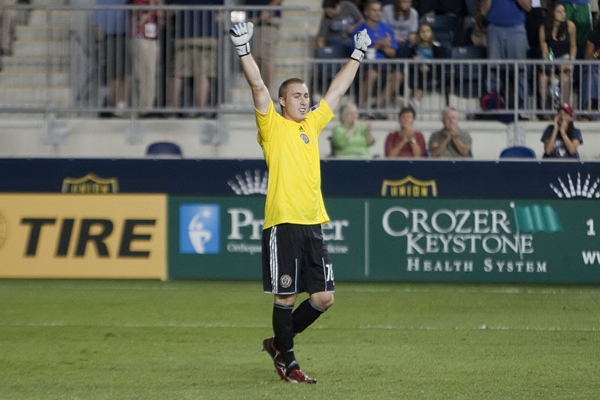
Knighton with the Union’s first shutout – 23 games into their inaugural season. (Photo: Daniel Gajdamowicz)
Incidentally, in his 652 minutes Brad Knighton put up a respectable 746.69 PR, 25 points above the average, and managed the first shutout in Union history. But he was also less than inspiring, and was waived on January 25, 2011 to make way for a savior…
2011
Some players are beloved by Philadelphia fans, even though a cursory review of their stats will leave you wondering why. Ron Hextall springs to mind–after a brilliant rookie season for the Flyers in 1986-87, he was dead average the rest of his career (to be fair, he picked up a never-healing groin injury that deprived him of a lot of the mobility that made him so brilliant his first year). But hey–he chopped down forwards with his stick, got into fights, and scored goals, so he is beloved.
As Philly entered 2011, the club knew it would have to significantly upgrade its goalkeeping. Enter Faryd Mondragon: a Colombian international, speaker of five languages, and as dominating a presence as could be found. Immediately installed as captain, Mondragon quickly became a fan favorite. His steely presence solidified the backline, and he guided the Union to its only post-season appearance to date. He was an MLS all-star. His all-too-soon departure–as part of a typically shady Peter Nowak transfer–saddened many Union fans. He is still revered as the club’s top keeper in its short history.
But there was a small group of dissenters who dared suggest that–maybe, just maybe–the emperor had no clothes. To those not charmed by his good looks or his fluency in English, Mondragon seemed way too slow off the line, and particularly beatable on low shots. After he was injured in the middle of the season, the acrobatic athleticism showed by first round pick Zac MacMath in his games had many wondering whether the torch should be passed, and passed quicker than expected.
So what do the data show?
|
Name |
Team |
Min. |
Svs |
GA |
ShO |
GAA |
PR |
+/- |
||
|
1 |
Josh Saunders |
Los Angeles |
1639 |
55 |
17 |
8 |
0.93 |
768.28 |
64.07 |
|
|
2 |
Kasey Keller |
Seattle |
3060 |
110 |
37 |
9 |
1.09 |
753.10 |
50.41 |
|
|
3 |
Nick Rimando |
Real Salt Lake |
2970 |
95 |
36 |
13 |
1.09 |
729.60 |
29.26 |
|
|
4 |
Matt Reis |
New England |
2430 |
111 |
43 |
5 |
1.59 |
727.12 |
27.03 |
|
|
5 |
Jon Busch |
San Jose |
3060 |
113 |
44 |
7 |
1.29 |
724.88 |
25.01 |
|
|
6 |
Dan Kennedy |
Chivas USA |
2880 |
100 |
39 |
9 |
1.22 |
724.25 |
24.45 |
|
|
7 |
Kevin Hartman |
Dallas |
2970 |
85 |
35 |
13 |
1.06 |
712.37 |
13.76 |
|
|
8 |
Tally Hall |
Houston |
3060 |
99 |
41 |
6 |
1.21 |
711.72 |
13.17 |
|
|
9 |
Troy Perkins |
Portland |
2610 |
91 |
38 |
9 |
1.31 |
710.37 |
11.95 |
|
|
10 |
Jimmy Nielsen |
Kansas City |
2767 |
79 |
35 |
7 |
1.14 |
697.10 |
0.01 |
|
|
11 |
Stefan Frei |
Toronto |
2406 |
106 |
49 |
6 |
1.83 |
690.31 |
-6.10 |
|
|
12 |
William Hesmer |
Columbus |
2880 |
92 |
44 |
8 |
1.38 |
681.19 |
-14.31 |
|
|
13 |
Bill Hamid |
DC United |
2392 |
77 |
37 |
7 |
1.39 |
680.20 |
-15.20 |
|
|
14 |
Joe Cannon |
Vancouver |
1800 |
66 |
32 |
3 |
1.60 |
678.91 |
-16.36 |
|
|
15 |
Sean Johnson |
Chicago |
2520 |
76 |
37 |
7 |
1.32 |
677.05 |
-18.03 |
|
|
16 |
Faryd Mondragon |
Philadelphia |
2385 |
49 |
28 |
7 |
1.06 |
639.59 |
-51.75 |
|
|
17 |
Matt Pickens |
Colorado |
3060 |
117 |
77 |
8 |
2.26 |
609.43 |
-78.89 |
|
What an interesting picture–once again, a Union netminder is next-to-last in MLS in goalkeeper perseverance. We see Mondragon put up a PR that was only ten points better than that of Seitz in 2010, and a good 50-plus points below the league average.
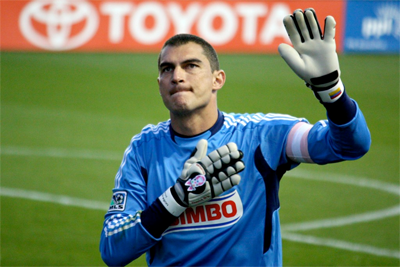
“He’s big…” but not so quick–Faryd Mondragon could run a defense, but couldn’t stop a shot. (Photo: Paul Rudderow)
And, yet, we also see that Mondragon was tied for second in GAA (1.06), and notched 7 shutouts. In all the years of MLS (and NASL) goalkeepers, never has a goalkeeper with such a low GAA been so bad at actually stopping shots when he was actually asked to (with the lone exception of Nick Rimando’s similarly schizophrenic 2004 season).
Does all this mean Mondragon was rubbish? Absolutely not. Rather, what it shows is that the Colombian was expert at organizing a defense, and had his fullbacks playing in such a way that minimized the number of shots he had to face–Mondragon made the fewest saves, and faced the second fewest number of shots, in MLS. Also, Mondragon’s adroitness at handling crosses does not show up on the stat sheet. Nevertheless, when called upon to actually, you know, make a save, St. Faryd was not so hot.
Ultimately, the stats basically confirm the perception that both the Mondragon lovers and haters came away with in 2011: great leader, lousy athlete.
Does this make him the Union’s Ron Hextall? Only time will tell.
Meanwhile, for all his athleticism in his eight appearances, MacMath also showed he wasn’t very adept at stopping the shots he faced, coming in with a 603.2 PR, even more dismal than Mondragon’s. Nevertheless, Nowak off-loaded the experienced Colombian in the close season, and cast his lot with the young Maryland alum.
Incidentally, Chris Seitz notched a breathtakingly bad 509 PR for Dallas. However, he only got to stink it up in one game, so it was not so bad. Incidentally, another Union alum–Brian Perk–shone in his one appearance with Los Angeles, with a 902 PR. Many who saw him excel in his brief appearances for Philadelphia in the Glasgow Celtic and Manchester United friendlies in 2010 wonder why the Union gave up on him so quickly.
2012
Coming off a successful season and a playoff appearance, Union manager Peter Nowak promptly went insane, giving away Mondragon and leading scorer Sebastien Le Toux, alienating fan favorite Danny Califf, and bringing in a lot of nondescript players with “z” in their surnames.
Taking over at that most important of positions was second-year goalkeeper Zac MacMath. Although pretty shaky in his 2011 debut appearances, it was understood that goalkeepers generally improve with age and experience, and the hope was added maturity would combine with MacMath’s considerable athletic gifts to give the Union solid goalkeeping for years to come.
Derailed from the start by Nowak’s unfathomable tactics and shenanigans, the Union missed the playoffs. For his part, MacMath remained shaky throughout the year, and was rarely able to bail out a porous defensive corps–for all the great play of center back Carlos Valdez, the outside backs still found themselves too involved in the offense, leading to much exposure.
But was MacMath that bad? Let’s take a look:
|
Name |
Team |
Min. |
Svs |
GA |
ShO |
GAA |
Persev |
+/- |
|
|
1 |
Michael Gspurning |
Seattle |
1845 |
59 |
15 |
8 |
0.73 |
801.31 |
89.95 |
|
2 |
Bill Hamid |
DC United |
2087 |
88 |
24 |
8 |
1.03 |
791.08 |
80.74 |
|
3 |
Andy Gruenebaum |
Columbus |
2920 |
124 |
41 |
8 |
1.26 |
757.17 |
50.22 |
|
4 |
Sean Johnson |
Chicago |
2766 |
108 |
38 |
5 |
1.24 |
745.00 |
39.27 |
|
5 |
Jimmy Nielsen |
Kansas City |
3060 |
77 |
27 |
15 |
0.79 |
743.78 |
38.17 |
|
6 |
Nick Rimando |
Real Salt Lake |
2790 |
83 |
33 |
12 |
1.06 |
719.67 |
16.48 |
|
7 |
Matt Reis |
New England |
2430 |
92 |
39 |
6 |
1.44 |
707.68 |
5.68 |
|
8 |
Troy Perkins |
Port-Mont |
2767 |
101 |
43 |
7 |
1.40 |
706.59 |
4.70 |
|
9 |
Kevin Hartman |
Dallas |
2700 |
98 |
42 |
6 |
1.40 |
705.19 |
3.44 |
|
10 |
Tally Hall |
Houston |
2946 |
88 |
39 |
12 |
1.19 |
697.22 |
-3.73 |
|
11 |
Josh Saunders |
Los Angeles |
2430 |
80 |
36 |
9 |
1.33 |
694.43 |
-6.24 |
|
12 |
Ryan Meara |
New York |
1620 |
59 |
27 |
3 |
1.50 |
691.36 |
-9.01 |
|
13 |
Matt Pickens |
Colorado |
2859 |
107 |
49 |
7 |
1.54 |
691.35 |
-9.01 |
|
14 |
Zac MacMath |
Philadelphia |
2880 |
93 |
43 |
8 |
1.34 |
688.55 |
-11.54 |
|
15 |
Joe Cannon |
Vancouver |
2277 |
73 |
34 |
8 |
1.34 |
686.94 |
-12.98 |
|
16 |
Dan Kennedy |
Chivas USA |
2880 |
109 |
54 |
7 |
1.69 |
674.37 |
-24.30 |
|
17 |
Jon Busch |
San Jose |
2835 |
77 |
40 |
7 |
1.27 |
662.25 |
-35.21 |
|
18 |
Milos Kocic |
Toronto |
2430 |
82 |
47 |
3 |
1.74 |
640.97 |
-54.36 |
|
19 |
Donovan Ricketts |
Mont-Port |
2913 |
87 |
52 |
5 |
1.61 |
630.67 |
-63.63 |
While contributing the best PR by a goalkeeper in Union history, MacMath remains decidedly below-average, and well off the pace set by Seattle netminder Michael Gspurning. Still, far from terrible. In fact, for all the raves Dan Kennedy gets for tending goal for a horrid Chivas team, it turns out he is not doing a whole lot to help his cause. Many people would jump at the chance of a Kennedy-for-MacMath trade. Looking at these numbers, though, you’d have to think twice.
And, again, MacMath is a very young player–even younger by goalkeeper standards. With experience, he has to get better, right?
2013
Well, let’s take a look at the numbers so far as of September 11, 2013. Here are the PRs for goalkeepers who have played at least 10 games this year:
|
Name |
Team |
Min. |
Svs |
GA |
ShO |
GAA |
PR |
+/- |
|
|
1 |
Nick Rimando |
Real Salt Lake |
1980 |
69 |
22 |
8 |
1.00 |
762.84 |
64.01 |
|
2 |
Clint Irwin |
Colorado |
2333 |
75 |
26 |
10 |
1.00 |
746.90 |
48.07 |
|
3 |
Sean Johnson |
Chicago |
1890 |
70 |
25 |
4 |
1.19 |
741.87 |
43.04 |
|
4 |
Donovan Ricketts |
Portland |
2250 |
75 |
28 |
9 |
1.12 |
732.73 |
33.90 |
|
5 |
Michael Gspurning |
Seattle |
1935 |
61 |
23 |
9 |
1.07 |
730.53 |
31.70 |
|
6 |
Andy Gruenebaum |
Columbus |
1800 |
70 |
27 |
4 |
1.35 |
727.04 |
28.21 |
|
7 |
Raul Fernandez |
Dallas |
2070 |
83 |
34 |
7 |
1.48 |
715.05 |
16.22 |
|
8 |
Tally Hall |
Houston |
2430 |
85 |
35 |
6 |
1.30 |
713.27 |
14.44 |
|
9 |
Troy Perkins |
Montreal |
2340 |
88 |
37 |
8 |
1.42 |
709.34 |
10.51 |
|
10 |
Luis Robles |
New York |
2520 |
85 |
36 |
8 |
1.29 |
707.28 |
8.45 |
|
11 |
Brad Knighton |
Vancouver |
990 |
35 |
15 |
2 |
1.36 |
705.05 |
6.22 |
|
12 |
Jon Busch |
San Jose |
2520 |
92 |
40 |
5 |
1.43 |
702.21 |
3.38 |
|
13 |
Dan Kennedy |
Chivas USA |
2394 |
95 |
42 |
3 |
1.58 |
699.15 |
0.32 |
|
14 |
Joe Cannon |
Vancouver |
900 |
31 |
14 |
1 |
1.40 |
693.89 |
-4.94 |
|
15 |
Zac MacMath |
Philadelphia |
2520 |
82 |
38 |
10 |
1.36 |
688.10 |
-10.73 |
|
16 |
Jimmy Nielsen |
Kansas City |
2520 |
58 |
27 |
10 |
0.96 |
685.73 |
-13.10 |
|
17 |
Bobby Shuttleworth |
New England |
1973 |
57 |
27 |
9 |
1.23 |
682.83 |
-16.00 |
|
18 |
Bill Hamid |
DC United |
1800 |
62 |
31 |
4 |
1.55 |
671.83 |
-27.00 |
|
19 |
Joseph Bendik |
Toronto |
2520 |
76 |
40 |
3 |
1.43 |
659.78 |
-39.05 |
|
20 |
Carlo Cudicini |
Los Angeles |
1890 |
39 |
27 |
7 |
1.29 |
594.40 |
-104.43 |
Sigh.
It does not appear our boy Zac is growing into the job. In fact, he appears stagnant–registering a PR almost identical to that in 2012.
Despite sharing the league lead in clean sheets, MacMath remains below average as far as actually stopping the shots that get to the net. Of more concern is that he apparently is not learning to organize a defense, either–his 121 shots faced is fifth overall on the list. At least Mondragon could claim that his superior organizational skills limited the shots he had to face and, thus, limited his one glaring weakness–the inability to actually make a save.
Meanwhile, take some solace in the fact that Carlo Cudicini is every bit as bad as you thought he has been in 2013. Galaxy fans can’t get rid of him fast enough. Those numbers must gall Bruce Arena, himself a former goalkeeper (drafted by the New York Cosmos in 1973, in fact).
Conclusion
All told, it appears the Union have caught the Philadelphia goalie curse. Just as the Flyers have suffered by the lack of a lights-out netminder since about 1987, the Union have yet to find that Kevin Hartman-type keeper–someone who can consistently provide both organization and shot stopping on a consistent basis.
Wait…you mean he’s available? Tell Hack to pick up the phone…
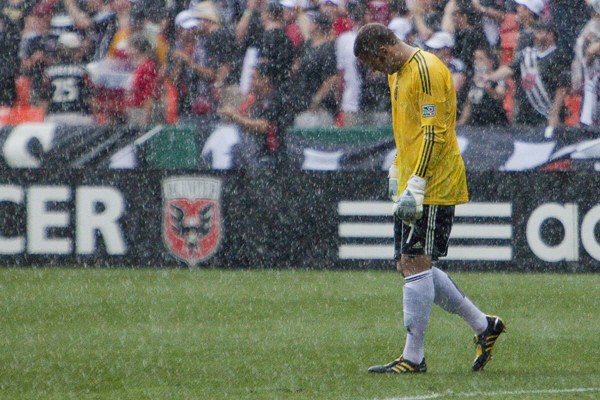
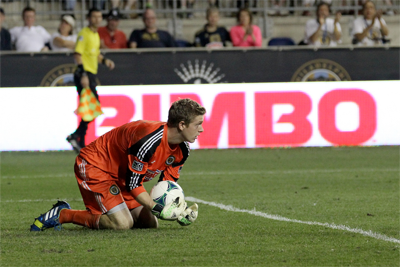
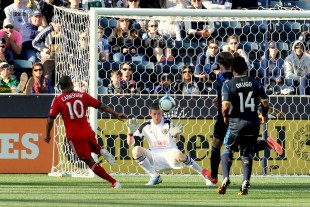

I think what this does is show us has golden a player Valdes was.
Fascinating analysis. The #2 keeper this year (according to these ratings) started the year as a fourth-stringer. And one of the anointed future USMNT keepers is three spots below MacMath.
Clint Irwin for USMNT?
I got to see Clint play in CO in one of his first games as a starter when he made that ridiculous penalty save, and I told my brother then that he should be in the USMNT short-list. He is extremely athletic, quick, strong, and vocal. Great combination of shot-stopping and organizational abilities. If only…
Love this post, Steve. Reminds me a great book “Moving the Goalposts,” check it out if you haven’t read it and are a fan of English football. Given how variable a goalkeepers results can be depending on the defense in front of him, this is one of the truly important and overlooked statistics. While it doesn’t reveal much about their organization and decision making, you cannot be a top-level keeper if you can’t stop shots. Period. And while Zac is still young, it is usually the organizational skills and decision making that improves with age, rather than shot stopping athleticism. I like Zac a lot, but I’m still on the fence if he can ever get to the elite category of keepers.
Thanks! You missed my winter series, where I plugged “Moving The Goalposts” repeatedly! Check out my earlier articles on ranking the competitiveness of certain eras, etc.
Before everyone decides to dump all over Zac, remember that he is still the youngest starting goalkeeper in the league. It’s fair to say no one will argue his game has improved since the Union signed the new back-up/mentor/coach.
Steve, you mean the Kevin Hartman that KC didn’t protect in the 2009 Expansion Draft? Yeah, that one still kills me.
Yeah…money issues. Then they cut him loose, but would let him play for anyone else at first. He is the reason the players’ union pushed for the re-entry draft (in lieu of real free agency).
Perk was let go because he missed a practice. Shame…kid was a cat.
Seriously? Jesus, is that pathetic. Yeah, I was pretty impressed with him during the Celtic and Man U matches.
” With experience, he has to get better, right?”
Two words refute this – Freddy. Adu.
The one that kills, we were first in 2010 in the allocation order and had Troy Perkins lined up (who has outperformed Union keepers in all of the above charts).
We dealt our spot to DCU for Fred and a pick (McInerny).
I would take McInerny over Perkins every day of every week and probably also on days/weeks that are only hypothetical
In 2013 yes, but in 2010? I’m taking the proven keeper over the 17yo on every day, including hypothetical days. A high school kid isn’t one I’d want to launch my franchise with.
There is no question that Zack started out the year pretty rough and has done nothing but grow over the 2nd half of the season.
I think Zack is quickly becoming one of the top netminders in the league. Lets not forget, the horrible marking we’ve had on set pieces and our complete lack of midfield play.
Zack is one of the bright spots on the team and by this time next year, I’m willing to be he is in the top 5 to 7 on that list.
PS Do we get Valdes back next year, or do we have to wait till the world cup is over.
Valdes will be sold, he isn’t coming back.
You think Zac will be top 5-7 next season?
Here’s a list of keepers I’d rather have:
Troy Perkins
Nick Rimando
Sean Johnson
Joe Cannon
Michael Gspurning
Donovan Ricketts
Tally Hall
Jimmy Nielsen
Bill Hamid
A few others I’d have to think about – Clint Irwin, Jon Busch
cannon please, hamid is great one game horrendous the next, and perkins is a middle of the road keeper(jack mac was worth it) givw macmath more time, gk take a while generally speaking unless we can get a great keeper ie keller gspurning let’s ride the kid next year